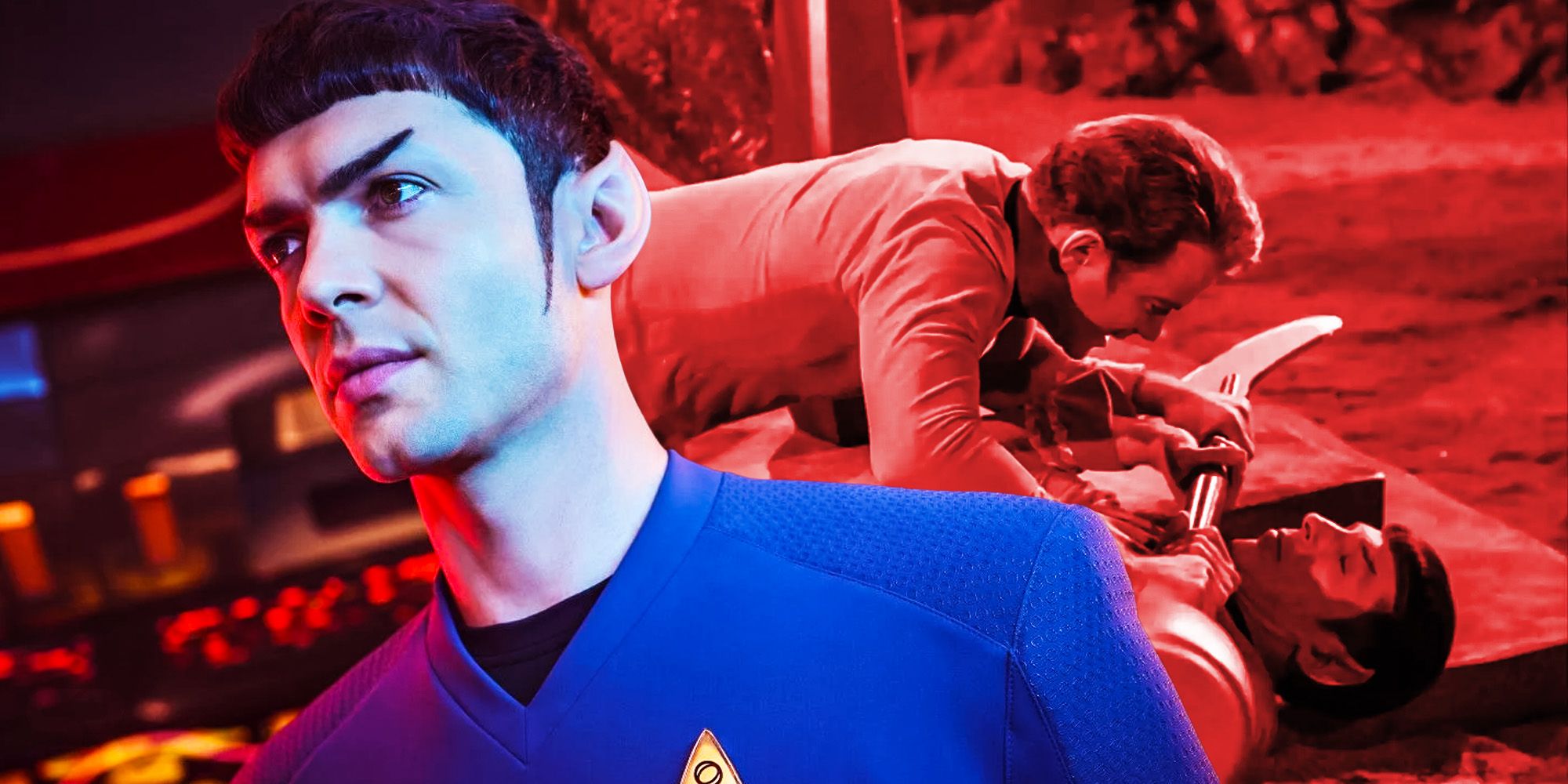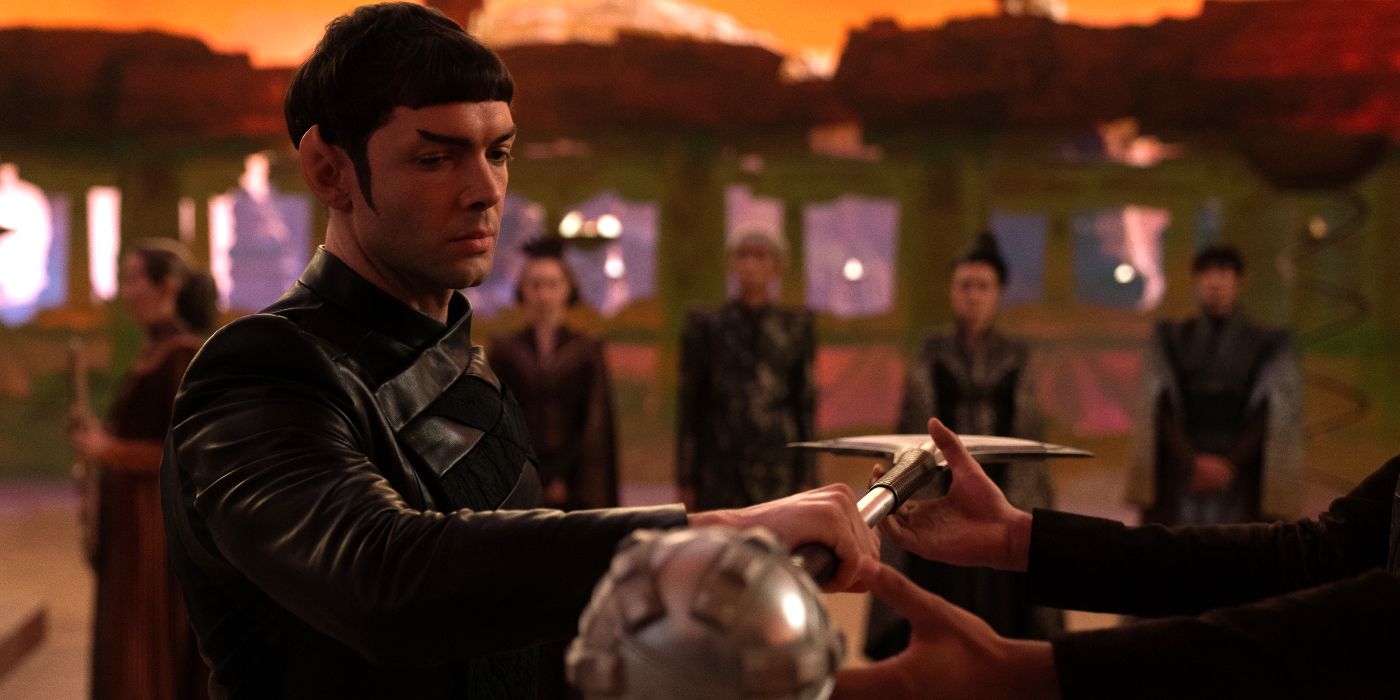
Warning: SPOILERS for Star Trek: Strange New Worlds Episode 5 – “Spock Amok”
Spock’s (Ethan Peck) dream at the start of Star Trek: Strange New Worlds episode 5 gives new context and explains what happens 8 years later in the Star Trek: The Original Series episode, “Amok Time.” Strange New Worlds episode 5, “Spock Amok,” is the Paramount+ series’ first comedic episode in the vein of Star Trek: The Original Series‘ “The Trouble With Tribbles.” The main source of hijinks is a mind-meld accident that causes a hilarious body swap between Spock and his Vulcan fiancée, T’Pring (Gia Sandhu).
Unfortunately for Spock and T’Pring, Star Trek canon dictates that they will not marry. T’Pring and Spock were promised to each other as children and, in Strange New Worlds episode 1, they are in love and fully intend to marry. Yet Spock is dedicated to his Starfleet career and he answers the call to join the Enterprise on its new five-year mission. For her part, T’Pring promised that she would not “chase” Spock “around the galaxy” in order to marry him. In TOS‘ classic Vulcan episode, “Amok Time,” T’Pring (Arlene Martel) was true to her word. When Spock (Leonard Nimoy), who was suffering from pon farr, returned to Vulcan, he found that T’Pring had chosen a different mate, and she engineered events so that Spock fought Captain James T. Kirk (William Shatner) to the death in the Vulcan ritual of kal-if-fee to free herself of her commitment to Spock. At the end of the kal-if-fee, Spock and T’Pring’s relationship was completely over.
Spock’s dream in Strange New Worlds episode 5 was a note-perfect recreation of TOS‘ “Amok Time” and how it depicted Vulcan. It even had the unforgettable theme music that played when Spock fought Kirk. The half-Vulcan Science Officer’s hidden fear that T’Pring would reject him because he is “too human” manifested itself with Spock, who suddenly appeared fully human, being forced to fight a fully-Vulcan Spock, who T’Pring chose as her mate. However, Spock’s dream takes on a different context when “Amok Time” is taken into consideration. Because Spock’s dream is so identical to “Amok Time,” it becomes a premonition of what would happen 8 years later, although Spock can’t know that yet in Strange New Worlds. But this retcon means Leonard Nimoy’s Spock may have recalled the dream he had in 2259 when he arrived on Vulcan and saw T’Pring again in 2267.

“Amok Time” has a built-in explanation for why Spock didn’t react to how similar the events of T’Pring’s kal-if-fee were to this dream in Strange New Worlds. Spock was in the grip of pon farr-derived madness and he wasn’t acting rationally. It was the shock of ritual combat and Spock believing he killed Kirk, his Captain and best friend, that snapped him out of pon farr and returned him to normal. But once Spock regained his wits, he must have silently taken stock that he dreamed virtually this entire scenario almost beat-for-beat in 2259 and his younger self’s nightmare came true.
Spock rendered irrational by pon farr in “Amok Time” also sheds new light on how the Vulcan Science Officer reacted to Nurse Christine Chapel (Majel Barrett) in the episode. “Spock Amok” established that Spock and Chapel (Jess Bush) became friends in Strange New Worlds, and he came to Christine for help when his mind was accidentally placed in T’Pring’s body. It also means that Chapel knew all about T’Pring years before Captain Kirk took over the Enterprise and they apparently never spoke about Spock’s fiancée to others on Kirk’s ship. Further, because Spock’s dream in Star Trek: Strange New Worlds came true in TOS‘ “Amok Time,” it makes the disappointment Spock felt about T’Pring’s actions even more poignant. Further, Spock and T’Pring’s happy ending in “Spock Amok” becomes sadly ominous knowing what the future will bring.
Star Trek: Strange New Worlds streams Thursdays on Paramount+.
Go to Source
Author: John Orquiola